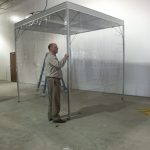
As you may have noticed, we depend on more and more electrical and electronic equipment every year. We rely on this equipment for providing everything from safety to entertainment. Almost all of this equipment relies on printed circuit boards (PCBs). The electronic circuit board manufacturing process is very delicate and requires precision. For some high-density circuit boards, humidity or contamination can cause yield or field failures. Therefore, the process of creating PCBs and electronic components must be carried out in a cleanroom
Cleanrooms for Electrical Components
The class of cleanroom required — or the number and size of particles allowed per cubic meter — differs for all materials. You need to know what the specifications are for the product and materials you are manufacturing when procuring the cleanroom needed for making electrical components and other items. PCBs, for example, are typically manufactured in ISO 7 or 8 cleanrooms. Flexible printed circuit production is an imaging-intensive operation. Imaging processes may be done in an ISO 6 cleanroom.
In its most basic form, a PCB is an insulating substrate with conductive traces. Chips and other electronics are mounted and interconnected on top of it to form an electronic package. Conductive traces may be on one side of the board, both, or within the board. You’ve seen that our electronic devices tend to get smaller as they become more sophisticated. As chips get smaller, PCBs get smaller, too. Without a cleanroom for making electrical components, contamination can occur between the line widths of the circuit boards. The smaller the line width and spacing, the more particles can contaminate it.
In fabricating a printed circuit, a photoresist is used to mask circuit lines for the etching process. The photoresist can attract and hold water molecules from the air. Moisture can affect the photoresist’s integrity and reduce its performance during the imaging and etching operations. Humidity control is a paramount concern in the PCB cleanroom. According to Bryair.com, “…exposure to high humidity/moisture can lead to microscopic corrosion on the surface of the circuits. This causes adhesion failures, surface defects and decreased performance of the Circuit Board.”
Maintaining imaging artwork for multilayer circuits at a consistent temperature and humidity will also help layers align properly. For optimal control, humidity levels are usually maintained at 20% – 35% at about 68 degrees F.
Once the printed circuit board electrical components are fabricated in your cleanroom, the component assembly step can involve static sensitive components, so electrostatic discharge needs to be controlled. Additionally, electrostatic discharge (ESD) attracts contaminants, so controlling it in the cleanroom is an ongoing, necessary process. People and machinery generate the most ESD, but so can products. Using air deionizing fans and bars can help eliminate electrostatic discharge along with proper grounding of operators and machinery.
Getting Your Cleanroom for Producing Electrical Components
The environment where your electronic circuit board manufacturing process takes place, and the cleaning equipment and upkeep methods you utilize to maintain your cleanroom’s ISO rating make all the difference. Gerbig Cleanrooms can build you the right class of cleanroom and help you factor in humidity and ESD control, as well as your other specific needs. Contact our experts to get your cleanroom for making electrical components.